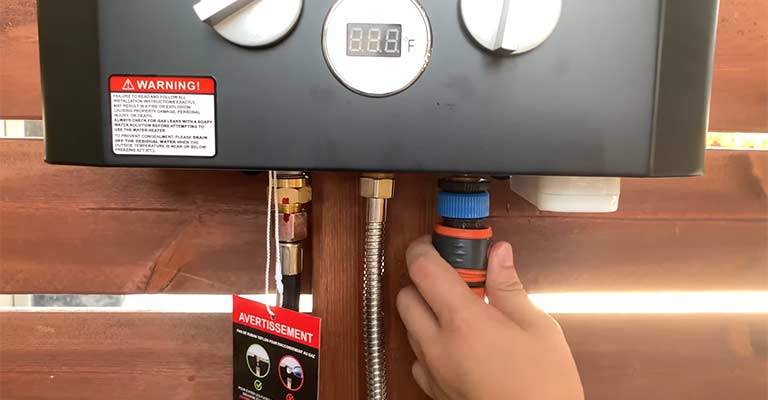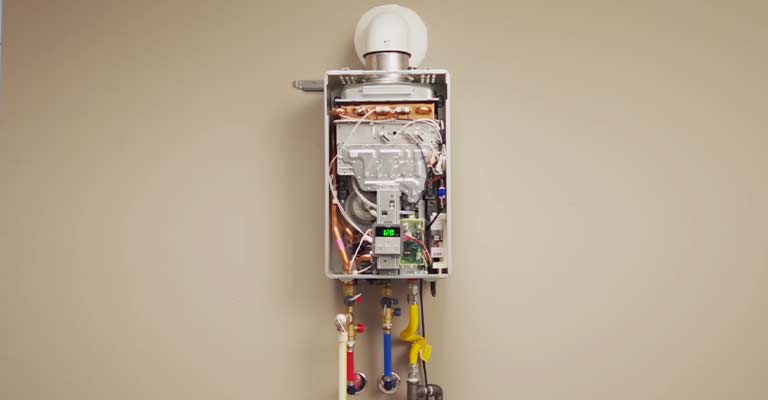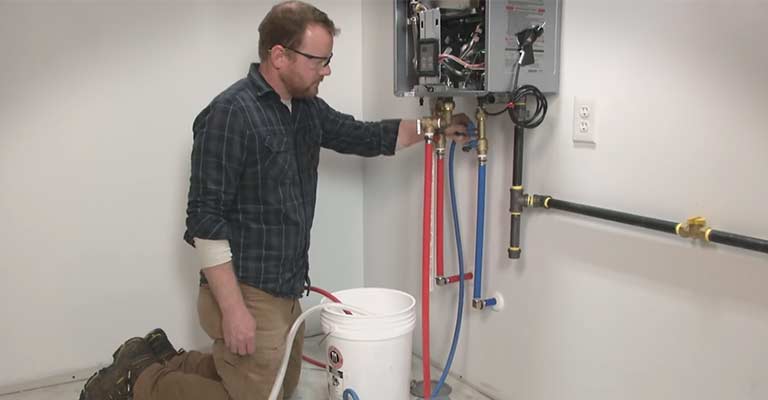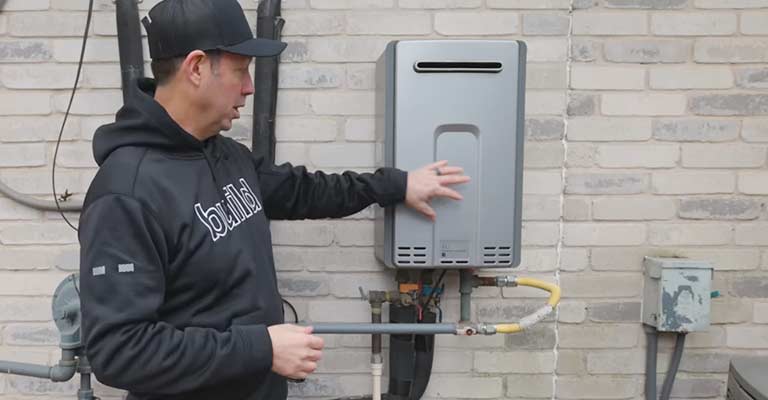Even when installed inside your house, a tankless water heater can freeze. You can fix the problem by following these steps.
It’s possible for your garage-mounted tankless water heater to freeze, leaving you without hot water.
Even though frozen tankless water heaters are not as common as frozen pipes, they may need repairs or even replacement.
Therefore, it is equally important to know how to thaw your unit and how to prevent it from freezing in the first place. Be careful not to operate the unit. Here are a few tips for thawing a frozen tankless water heater:
- Turn off the gas and water shutoff valves serving the water heater.
- Shut down the heater’s circuit breaker.
- Let the system thaw, then open the water supply valve and see if water flows.
- Make sure that the unit is leak-free, including its internal parts, the plumbing system, and the external pipes.
- Reconnect the electricity and open the valves if the water is flowing normally.
If you notice any leaks or damage to the pipes serving your water heater, contact a plumber immediately. You should not attempt to fix the unit yourself.
Why Do Tankless Water Heaters Freeze?
Water heaters with tankless technology only produce hot water when it’s needed, unlike traditional water heaters.
In cold weather, because hot water is not continuously flowing through these tankless systems, they may freeze, even though they are highly energy efficient.
There is freeze protection built into many tankless water heaters, but freezing can still occur during extremely cold periods or power outages.
Preventing a Tankless Water Heater from Freezing

If you drain your water heater or set it to low flow, you can prevent the water from freezing.
1. Running A Low Water Flow
Tankless water heaters may not be able to protect themselves from freezing when the temperature drops too low during the winter.
Water flow can be reduced when there is a power outage as well. However, if you turn off the power, close the gas supply valve, and open the hot water faucet, you will be able to prevent the unit and external piping from freezing.
The water flow should be limited to about 1/10th of a gallon per minute (the water stream should not exceed .20 inches wide). Your plumbing will freeze less as the flow of water is reduced.
2. Run The Hot Water
Frozen tankless water heaters are particularly susceptible to damage from standing water freezing and expanding.
Make sure that one of your faucets is running with a small stream of warm water to eliminate this risk. You can still save money on water heater repairs or replacements even if you see a slight increase in your water bill.
3. Draining A Tankless Water Heater

When a cold spell is ahead and/or you’re going on vacation, you can drain a tankless water heater that doesn’t have freeze protection built in.
Make sure the cold water and gas supply are off, the temperature control is off, as well as the electricity. To relieve pressure, open a hot water tap.
Now that the drain caps have been removed from the hot/cold isolation valves, you can place a bucket under the unit to catch the water.
As hot water is released under pressure, it will be collected in the bucket. After removing the cold-water inlet filter, the heater’s drain plugs should also be removed.
4. Prepare For Power Outages With A Generator
There is usually a freeze protection feature built into most tankless water heaters. In this system, ice is melted inside the tank using an electric system.
A power outage, however, will prevent this freeze protection from working properly. By connecting your water heater to a generator, you will be able to protect this function during an outage.
5. Built-In Freeze Protection
When the temperature drops below a certain level, some models will automatically activate ceramic heaters to prevent freezing.
In the event that the primary heaters fail, sensors are able to detect below freezing temperatures and turn the unit on and off so that the unit does not freeze.
In the event of a power failure, freeze protection solenoid valves (also known as drain down solenoid valves) automatically open to drain the heater. You can add them to any model, but they’re more common on higher-end models.
6. Winterizing A Tankless Water Heater

By turning off the gas, water, and power to your water heater, you can winterize it if you’re going to be away all winter.
The first step in draining your hot water unit is to turn off the cold-water supply and open the solenoid valves.
If freezing occurs, remove the inlet filter on the cold-water line to allow room for expansion.
In order to prevent airflow being disrupted by debris or animals, cover the intake and exhaust vents if you can access them.
Insulating your pipes is another way to protect them. For heating when it is most needed, some insulators come with a pipe heating cable and thermostat.
7. Install A Solenoid Valve
Tankless water heaters drain themselves automatically if there’s a power outage thanks to a solenoid valve.
In the presence of electricity, solenoids stay closed, and in the absence of electricity, they open. When the power goes out in cold weather, your system is protected from freezing.
How Risky Is It For Your Tankless Water Heater To Freeze?
Depending on the model and location, tankless water heaters are susceptible to freezing. The risk of fire is higher for units located outside.
A dedicated heating element is often included in many brands to prevent internal components from freezing when the outside temperature dips below freezing.
Temperature sensors trigger the unit to turn on and warm up when it detects a change in temperature. A power outage can still cause such a unit to ice up.
When I Cut Water To The House During Vacation, Should I Turn Off My Tankless Gas Water Heater?
You should drain the water tank and any other exposed pipes after cutting off the water. The water heater’s gas valve should also be shut off.
The water in the unit could freeze and cause damage if it is exposed to freezing temperatures, so make sure you drain it of all water that could freeze and cause damage.
A hot water faucet can be left open somewhere in the house if you feel lucky and don’t intend to be gone for very long…just a tiny bit… in order to keep it from freezing and prevent exposed water pipes from freezing.
Final Tips
You should place your outdoor unit in an area that is wind-free if you can. The air may be warmer in an isolated location.
The tankless water heater can also be protected from cold temperatures and ice and snow by installing a tankless water heater cover.
It is common for tankless water heaters to include freeze protection. Hence, if the temperature drops close to freezing, the burner will turn on to maintain the temperature.








